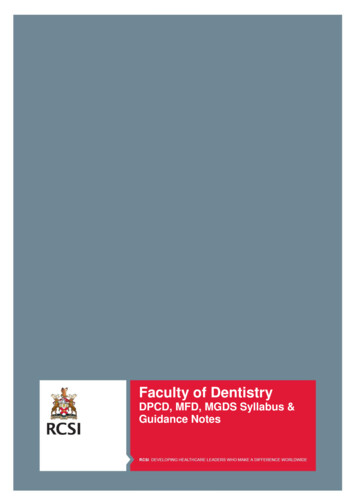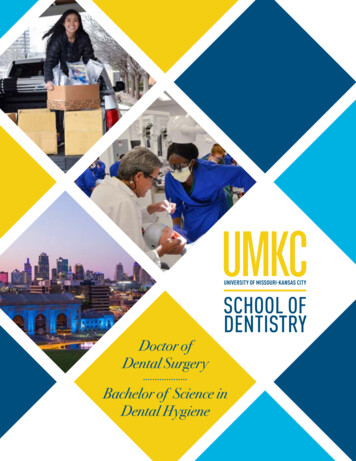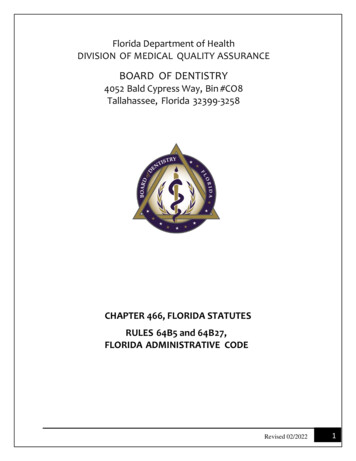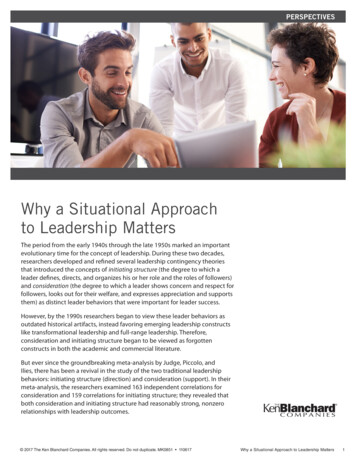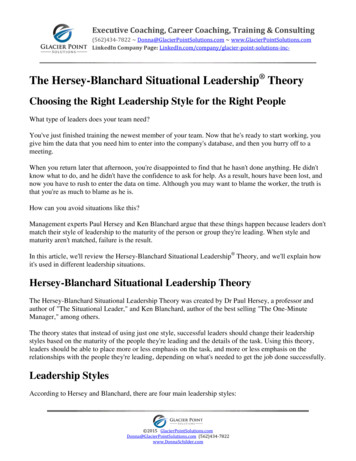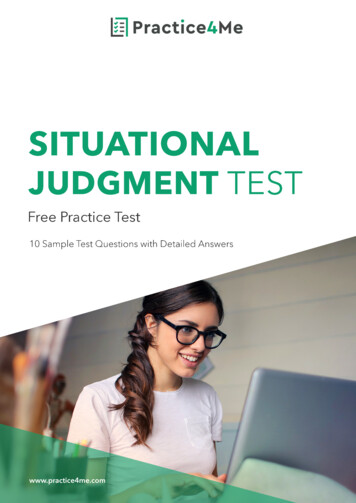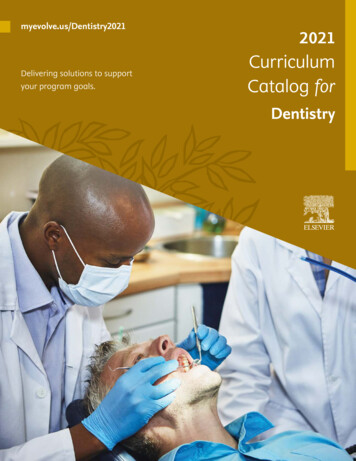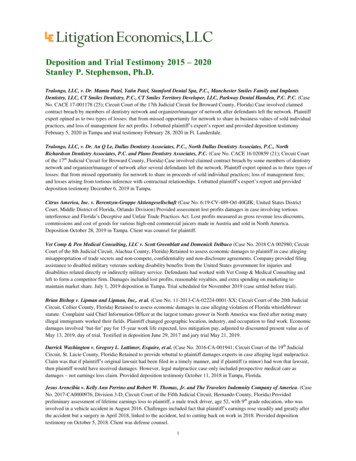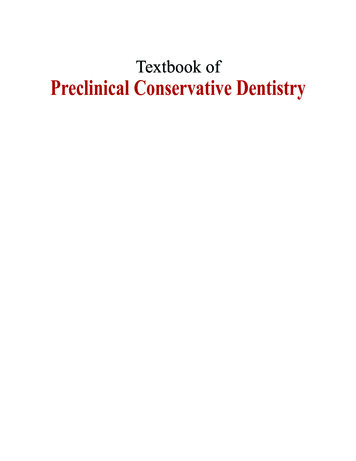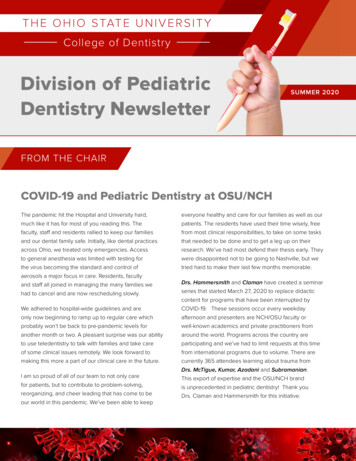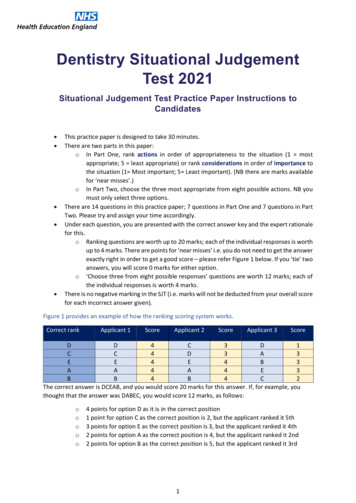
Transcription
Dentistry Situational JudgementTest 2021Situational Judgement Test Practice Paper Instructions toCandidates This practice paper is designed to take 30 minutes.There are two parts in this paper:o In Part One, rank actions in order of appropriateness to the situation (1 mostappropriate; 5 least appropriate) or rank considerations in order of importance tothe situation (1 Most important; 5 Least important). (NB there are marks availablefor ‘near misses’.)o In Part Two, choose the three most appropriate from eight possible actions. NB youmust only select three options.There are 14 questions in this practice paper; 7 questions in Part One and 7 questions in PartTwo. Please try and assign your time accordingly.Under each question, you are presented with the correct answer key and the expert rationalefor this.o Ranking questions are worth up to 20 marks; each of the individual responses is worthup to 4 marks. There are points for ‘near misses’ i.e. you do not need to get the answerexactly right in order to get a good score – please refer Figure 1 below. If you ‘tie’ twoanswers, you will score 0 marks for either option.o ‘Choose three from eight possible responses’ questions are worth 12 marks; each ofthe individual responses is worth 4 marks.There is no negative marking in the SJT (i.e. marks will not be deducted from your overall scorefor each incorrect answer given).Figure 1 provides an example of how the ranking scoring system works.Correct rankApplicant 1ScoreApplicant 2ScoreApplicant 3ScoreDD4C3D1CC4D3A3EE4E4B3AA4A4E3BB4B4C2The correct answer is DCEAB, and you would score 20 marks for this answer. If, for example, youthought that the answer was DABEC, you would score 12 marks, as follows:ooooo4 points for option D as it is in the correct position1 point for option C as the correct position is 2, but the applicant ranked it 5th3 points for option E as the correct position is 3, but the applicant ranked it 4th2 points for option A as the correct position is 4, but the applicant ranked it 2nd2 points for option B as the correct position is 5, but the applicant ranked it 3rd1
In this practice assessment you will be presented with scenarios typical of those thatFoundation Dentists encounter.Therefore, for each scenario, consider yourself to be a Foundation Dentist.Please answer what you should do when responding to the questions. We appreciate that youmay sometimes feel that you would like more information before answering. However, pleasegive your best answer based on the information provided in the question.Please note: There is a glossary on page 3 with definitions of some of the terms that are usedwithin the question paper. You may find it useful to consult this if you do not understand aterm. Terms which are included in the glossary are marked with an asterisk.2
GlossaryTermDefinitionAudit/ Clinical AuditBasic life support (BLS)Review and analysis of processes and outcomes related to clinical practice.The level of medical care which is used for people with life-threatening illnessesor injuries until they can be given full medical care at a hospital.Caldicott GuardianA senior person responsible for protecting the confidentiality of patient andservice-user information and enabling appropriate information sharing.Care homeAn institution providing accommodation and care for people who are unable tolook after themselves.Certified equipment (CE)Certified equipment marking shows that the manufacturer has checked thatthese products meet EU safety, health or environmental requirements.Case-based discussion (CbD) A CbD is a structured discussion with your Educational Supervisor designed toassess your professional judgement in a clinical case.Child and vulnerable adultA nominated individual responsible for safeguarding and promoting the welfaresafeguarding leadof young people and vulnerable adults.Critical incidentSignificant event, critical event.Cross-infection control lead The person responsible for ensuring that all staff comply with practiceprocedures, in order to prevent cross-infection or cross-contamination.Educational supervisorA designated educational supervisor responsible for co-ordinating training(trainer)throughout the training period and responsible for monitoring a FoundationDentist’s (trainee’s) progress to ensure any concerns and difficulties areidentified and resolved as quickly as possible.Electronic PersonalA secure and transferable personal record of a Foundation Dentist’s (trainee's)Development Plan (E-PDP) / educational and personal development. It incorporates the assessment tools fore-portfolioassessing and monitoring the performance of Foundation Dentists (trainees), tohelp determine the best way to satisfy these requirements and ensure aFoundation Dentist (trainee) is able to demonstrate a commitment to lifelonglearning.Foundation day releaseAs part of the Dental Foundation Programme, Foundation Dentists (trainees)must attend a regular educational course away from the training practice duringterm time.General Dental CouncilAn organisation which regulates and registers all dental professionals working in(GDC)the United Kingdom. The GDC is tasked with ensuring that all dental professionalshave been adequately trained to join the registers and maintain fitness topractise throughout their career. The GDC also provides advice to patients andthe public, and manages complaints about dental professionals.General Practitioner (GP)A doctor based in the community who treats patients with minor or chronicillnesses and refers those with serious and acute conditions to a hospital.HapticRelating to the sense of touch, in particular relating to the perception andmanipulation of objects using the senses of touch and proprioception.HyperdontiaThe condition of having supernumerary teeth, or teeth that appear in addition tothe regular number of teeth. They can appear in any area of the dental arch andcan affect any dental organ.Indemnity Organisation /Professional organisation which undertakes to protect, support and safeguardDental Protectionthe character and interests of registered medical and dental practitioners in theOrganisation / DentalUnited Kingdom, and elsewhere.3
Protection Society / DefenceOrganisationJury Central SummoningThe government organisation that are responsible for finding jury members to sitBureau (JCSB)in Crown courts.Jury SummonsA court order, which means you have to attend at the time and place stated sothat a jury can be selected, unless you have been excused.Local Education and Training A National Health Service (NHS) Deanery is a regional organisation responsibleBoard (LETB) / Deaneryfor postgraduate medical and dental training. In England, Deaneries are now partof Health Education England and its Local Education and Training Boards (LETBs).Multi-source feedbackA process whereby feedback on your performance is elicited from a range ofcolleagues who work with you.National Institute for Health Provides national guidance and advice to improve health and social care.& Clinical Excellence (NICE)National Health ServiceIn the United Kingdom, the NHS is a system that provides free medical care and(NHS)subsidised dental care and is paid for through taxes.Perforate/PerforatedTo pierce and make a hole or holes in.Postgraduate DeanPostgraduate Deans commission and manage the delivery of postgraduate dentaleducation and training. They are charged with developing and quality managingtraining so that trainees can reach their full potential.Primary Care Organisation / A local office of an NHS body that contracts for NHS dental services and worksLocal Area Team (LAT)with Local Authorities and other agencies that provide health and social carelocally to ensure that local communities’ needs are being met.Significant eventCritical incident, critical event.Social ServicesA department of the local council with responsibility for assessing the needs of,and providing support to, older, disabled or vulnerable people and children in thecommunity in line with statutory legal requirements.TemporiseTo temporarily restore a tooth.Training Programme Director The individual responsible for co-ordinating training together with all designated(TPD)trainers for one particular scheme in a Deanery area/LETB.TutorialA class in which a tutor or educational supervisor (trainer) gives intensiveinstruction in some subject to an individual Foundation Dentist (trainee) or asmall group of Foundation Dentists (trainees).Vulnerable adultAn individual aged 18 years or over who is, or may be, in need of communityservices due to age, illness or a mental or physical disability; who is, or may be,unable to take care of himself/herself, or unable to protect himself/herselfagainst significant harm or exploitation.4
PART ONE In this part you will be presented with scenarios followed by five possible responses.Answer the scenarios with what you should do as a Foundation Dentist.1. Your practice uses a new computer system that you are unfamiliar with and you have haddifficulties in using this system over the last few weeks. The system allows you to documenteach patient case and send an instant message to the receptionist if an appointment needs tobe booked. The receptionist complains to you for not sending an instant message through toher about a case that needs a follow-up appointment. This is the second time that thereceptionist has complained to you for not sending instant messages.Rank in order the following actions in response to this situation (1 Most appropriate; 5 Leastappropriate).A. Apologise to the receptionist, informing her that you will make an effort to improve.B. Ask the receptionist to give you a demonstration of how to use the system.C. Inform the receptionist that you will become familiar with the system in time.D. Inform the receptionist that you will manually notify her of appointments instead.E. Stay after the end of your shift to familiarise yourself with the new computer system.Answer: BAECDRationale: This scenario is about demonstrating a willingness to keep up to date with technical skillsand a commitment to practice policy. Actively seeking out training in this area demonstrates awillingness to develop and take ownership of your own learning, and is the most proactive action totake (B). Openly acknowledging the challenges that you are facing in this area, apologising to thereceptionist and reassuring her that you intend to improve, again demonstrates commitment tolearning and understanding of the impact that your lack of skills in this area may have on thereceptionist’s work (A). Staying beyond your shift to familiarise yourself with the system is proactive,but may be less useful since this is breaking into your own time and you will not be able to receive anyguidance from colleagues. Moreover, you may already be fatigued from the day’s work, resulting inless retention of learning (E). Notifying the receptionist that you will become familiar with the systemin time, is not being proactive. You are taking no conscious steps to improve, and are just assumingthat you will eventually learn the required skills (C). Option C is however, preferable to Option D,because in the latter, you are consciously deciding to bypass the new computer system, demonstratingno commitment to learning and development and the impact that this has on the wider team (D).5
2. A 28 year old patient, Amba, attends for a crown fit. When you have replaced Amba’stemporary crown with a permanent one, you show Amba the final result in the mirror.However, Amba starts to cry and says “It looks awful – change it! The temporary crown wasbetter!”Rank in order the following actions in response to this situation (1 Most appropriate; 5 Leastappropriate).A. Advise Amba to wear the crown for 10 days, before returning to discuss how she is feeling.B. Seek advice from your educational supervisor* (trainer) about how to manage Amba’sdissatisfaction.C. Tell Amba that if she wants a better crown she will have to have this done privately.D. Review the before and after photographs with Amba, highlighting the improvement.E. Allow Amba to calm herself before exploring her feelings about the crown in more depth.Answer: EDBACRationale: This question is about demonstrating empathy and sensitivity towards a patient who isclearly distressed. Allowing the patient the opportunity to verbalise her feelings about the crown andwhy this has caused her distress is important. It allows you to develop a better understanding of thesituation, which could assist with your subsequent course of action, and also demonstrates to thepatient that she is at the centre of your care (E). Taking time to actively review the before and afterphotographs of the crown with the patient, allows her to develop a greater understanding of theclinical benefits of the permanent crown and may help the patient to realise and understand positivefeatures of the permanent crown that she may not have already done so (D). Seeking advice from asenior regarding appropriate management of the patient is proactive. However, this may be seen asquite impersonal. As this is your patient and you have undertaken the treatment which has led to herdistress, it makes more sense for you take ownership for remediating the situation (B). Advising thepatient to wear the crown and return if she is still not satisfied is not an effective way of immediatelyaddressing the patient’s distress and may be seen as quite dismissive (A). However, Option A wouldbe preferable to Option C as in the former, there may still be the potential for the situation to berectified if the patient is still dissatisfied following the 10 days, whereas the latter offers no solution,does not address the patient’s distress at all and may incorrectly assume that going privately is anoption for the patient (C).6
3. Your educational supervisor* (trainer) tells you that a concern has been raised about you bya member of staff. This member of staff has suggested to your educational supervisor (trainer)that you use too much dental jargon when going through treatment plans with your patients.You are not aware of this concern ever being raised about you previously.Rank in order the following actions in response to this situation (1 Most appropriate; 5 Leastappropriate).A. Practise explaining procedures to patients without the use of any dental jargon.B. Obtain further feedback from your educational supervisor (trainer) and dental nurse regardingyour use of dental jargon.C. Ask other staff members whether they know who made the complaint against you.D. Ask your patients to let you know if they do not understand anything when you go through theirtreatment plansE. Request that your educational supervisor (trainer) organises a meeting between you and themember of staff who made the complaint.Answer: BADECRationale: This question is about being readily able to accept feedback and use this to guidecontinuous professional development. Obtaining further feedback from people whom you workclosely with would be a proactive option. If you are able to gain as much information as possible onthe issue, then you will be able to generate a more thorough understanding of the area in which youneed to develop (B). Actively taking steps to practise communicating without the use of dental jargonis the next appropriate option, to enable the development of this skill. However, without seekingfeedback on your precise developmental requirements as per Option B, this action may not be asbeneficial as it could be (A). Asking your patients to let you know if they don’t understand anythingwhen you go through their treatment plans is proactive, but is not specifically addressing your use ofdental jargon (D). Requesting that your educational supervisor (trainer) organises a meeting betweenyou and the member of staff who complained, provides no additional value over and above seekingfurther feedback from the members of staff whom you work closely with, and could also be viewed asconfrontational. In addition, the member of staff who made the complaint may wish to remainanonymous and it is potentially not your educational supervisor (trainer’s) responsibility to beorganising such a meeting (E). Asking other staff members whether they know who made thecomplaint against you, again may be viewed as confrontational and unprofessional. Additionally, if thecomplaint was made anonymously, it is unlikely that this would yield answers and may cause otherstaff members to become distrustful of you (C).7
4. During your Dental Foundation Training (DFT) year, you agree to help your family with caringfor a very sick relative. You find that sometimes you are tired and distracted at work as a resultof spending most of your evenings caring for your relative. You are also falling behind withkeeping your Electronic Personal Development Plan* (E-PDP) up to date and fulfilling your DFTlearning objectives.Rank in order the following actions in response to this situation (1 Most appropriate; 5 Leastappropriate).A. Focus on your clinical work, resolving to catch up with your E-PDP at a later date.B. Discuss your concerns with your Training Programme Director* (TPD).C. Consider whether you should take time out from DFT, or defer until next year.D. Explain your professional commitments to your family, exploring whether someone else can helpto care for your sick relative.E. Ask your educational supervisor* (trainer) whether your clinical workload can be reduced.Answer: BDCEARationale: This question focuses on resilience and being able to cope with competing work andpersonal demands. Discussing the situation with your TPD is the most appropriate course of action ashe/she will be best placed to advise on all issues relating to your training and next steps in terms ofseeking the relevant support. It is also necessary to alert your TPD to the fact that you are strugglingwith your work so that he/she is aware of this and again, may well take the necessary action to reducesome of the pressure that you are under (B). Having an open conversation with your family regardingyour work commitments is also an appropriate response. They may not realise at this point that caringfor your relative is having an impact on your ability to perform at work and may readily be able toenlist someone else to assist in caring for your relative (D). Considering whether you should take timeout from DFT or defer until next year would mean that you are still able to care for your relativewithout this impacting on your performance in DFT. However, this would delay your qualification as adentist and does not consider alternative and potentially more mutually beneficial courses of action,in terms of the potential availability of additional support at work and/or someone else having theability to care for your relative (C). Asking your educational supervisor (trainer) whether your clinicalworkload can be reduced may be seen as unprofessional. This would put additional strain oncolleagues, who would need to take on some of your clinical duties in addition to their own. This isespecially the case, considering that in Option E, you are not being explicit regarding the reason forwanting to reduce your clinical workload and this could therefore be perceived as being due to a lackof motivation (E). However, Option E would still be preferable to Option A, as in the former, there isat least an element of proactivity whereas in the latter, you are taking no direct steps to address thepressure that you are currently under. By simply continuing with your work as best as you can andresolving to catch up with your E-PDP at a later date, you are likely to fall even further behind. In time,the pressure that you are under may start to have more serious consequences for your performancee.g. relating to patient safety (A).8
5. A dental nurse, Krishna, confides in you that she is no longer registered with the GeneralDental Council* (GDC) as she could not afford to pay the latest annual fee. You are aware thatall members of dental staff are required to be registered with the GDC and that your employerconducts annual checks of each staff member’s registration status. Krishna asks you to keepthis information to yourself as she plans to have her membership reinstated before youremployer does his next annual check.Rank in order the following actions in response to this situation (1 Most appropriate; 5 Leastappropriate).A. Explain the situation to your Dental Protection Society*, seeking advice on how to proceed.B. Offer to loan Krishna money so that she can pay her fees.C. Respect Krishna’s confidentiality, resolving not to inform anyone of her situation.D. Advise Krishna to explain the situation to your employer.E. Immediately inform yours and Krishna’s employer about the matter.Answer: DEABCRationale: This question is about upholding professional integrity, adhering to professional standardsand encouraging colleagues to do the same. Advising the dental nurse to explain the situation to youremployer, allows her ownership over the problem, emphasises the importance of honesty andopenness and provides the dental nurse with a chance to rectify the issue herself (D). Informing youremployer of the issue yourself, may also be seen as an appropriate response, as this ensures that theemployer is made aware of the issue instead of relying upon the dental nurse to do this herself.However, it is still more appropriate and more conducive to effective team working, to allow thedental nurse to opportunity to do this herself (E). Explaining the situation to the Dental ProtectionSociety may be seen as appropriate in that they will be able to advise on next steps, however, it wouldprobably be more useful and efficient to inform the employer directly as this is likely to be the advicethat the Dental Protection Society would offer in response to this situation in any case (A). Loaningthe dental nurse the money to pay her annual GDC fees would be less appropriate, as this is notnecessarily your responsibility and there is no guarantee that the dental nurse would be able to repaythe money (B). Respecting the dental nurse’s confidentiality and taking no action in response to whatshe has told you, is the least appropriate response as you are aware that she is practising without GDCregistration which is against the regulations and may expose your practice to the risk of legal challenge(C).9
6. One of your fellow DFT colleagues and good friend, Jeewon, confides in you that a patient hasbeen racist towards her today and that she is feeling very upset. Jeewon tells you that she hadfinished treating the patient, and as he was leaving the treatment room, he said “goodbye” toJeewon in Mandarin. You know that Jeewon is originally from South Korea and does not speakMandarin. Jeewon says that she never wants to see this patient again.Rank in order the following considerations in response to this situation (1 Most important; 5 Leastimportant).A. That Jeewon should feel supported and respected at work.B. Jeewon’s duty as a dentist to treat all patients equally and without discrimination.C. Whether this is a common occurrence for your other colleagues.D. The patient’s intentions when saying goodbye to Jeewon in Mandarin.E. Your personal experiences of discrimination from patients at work.Answer: ADBCERationale: This scenario focuses on supporting a team member who is upset after an interaction witha patient. The most important thing to consider in response to this scenario is Jeewon’s right to feelsupported and respected at work, even if she were not so clearly upset (A). It is also important toconsider the patient’s intentions as it may be comforting to Jeewon to know if they did not mean it ina disrespectful manner (D). Jeewon’s duty as a dentist to treat all patients equally, while important,does not rank highly in responding to present situation (B). Whether this is a common occurrence foryour other colleagues (C) and your personal experiences of discrimination from patients at work (E)are not relevant to supporting Jeewon and focusing on what she has experienced.10
7. Your usual dental nurse, Colleen, who you have worked with for the past 5 months, will soonbe leaving the practice and you are due to start working with a new dental nurse, Mark, nextweek. You tend to have difficulties remembering the names of dental instruments, andColleen would often work closely with you to double check that the correct instruments werebeing used. You have a good relationship with Colleen and often shared a friendly joke aboutyour inability to remember the names of dental instruments. You are aware that you will needto inform Mark of your working requirements when he joins the practice.Rank in order the following considerations in response to this situation (1 Most important; 5 Leastimportant).A. Mark’s perceptions of you for having difficulties remembering the names of dental instruments.B. The impact that your working requirements may have on Mark’s working style and preferences.C. Your working relationship with Colleen.D. Mark’s past experiences of working alongside dentists with specific working requirements.E. That your difficulties remembering the names of dental instruments will likely improve over time.Answer: BDCEARationale: This scenario focuses on working effectively as part of a team and the importantconsiderations in managing a working relationship with a colleague. The most important thing toconsider in this situation is the impact of your working requirements on Mark (B) followed byconsidering Mark’s past experience of working alongside dentists with various working requirementswhich would highlight how open he is to adapting his working style (D). While you working relationshipwith Colleen was important while you worked with her, it is less relevant now (C). While you mayimprove at remembering your Left and Right side over time (E), this is less important to consider nowas you currently still have trouble remembering. Finally, Mark’s perceptions of you, (A), are the leastimportant thing to consider in this scenario as, even if it is something that you are self conscious about,the charting needs to be done correctly.11
PART TWO In this part you will be presented with scenarios followed by a number of possible options.Answer the scenarios with what you should do as a Foundation Dentist.8. You are replacing a broken filling for an anxious patient. During the procedure, the dentalnurse stops you. She tells you that the patient is not coping well with the procedure and isbecoming increasingly upset and agitated. You were not aware that the patient was in distress.Choose the THREE most appropriate actions to take in this situation.A. Discuss with the patient what is distressing him.B. Apologise to the patient if you have caused him any distress.C. Advise the dental nurse, following the consultation, not to question your work in front of patientsin future.D. Ask the dental nurse how you should proceed.E. Ask your educational supervisor* (trainer) to take over the procedure.F. Ask the patient whether he would like you to continue with the procedure.G. Inform the dental nurse that the patient does not seem distressed to you.H. Reflect on why you did not notice that the patient was agitated and upset, following theconsultation.Answer: AFHRationale: This scenario focuses on ensuring that the patient is at the centre of care, being able torecognise when the patient is uncomfortable or respond to feedback that this is the case, and takingthe appropriate next steps. It is very important to discuss with the patient why he is distressed in orderto gain a better understanding of this which, in turn, may help you to lessen the distress (A). It is alsoimportant to explore with the patient whether he is happy for you to continue with the treatment; ifthis is not the case, treatment should cease immediately (F). You should also take the time to reflecton why you did not notice yourself that the patient was agitated, following the consultation, in orderto ensure that you do not miss these vital signs in the future (H). You should be able to take immediateand direct steps to address the patient’s distress yourself, instead of seeking advice or asking othermembers of staff to take over (D,E), in order to retain ownership of the situation and assure the patientof your own competence in dealing with his distress. Apologising to the patient for causing himdistress, would not be appropriate as at this stage, you are unaware of what is causing him distress.Apologising unnecessarily may reduce the patient’s levels of confidence in your ability, which in turn,may induce further distress (B). Disagreeing with and berating the nurse regarding her observations,again will not engender confidence in an already distressed patient and will also not be conducive toan effective and healthy working relationship with the nurse moving forwards (C,G).12
9. You have been working in your training practice for several months and have built up a goodworking relationship with the practice manager, Mrs Charles. One day, Mrs Charlesapproaches you, and asks you to start telling new patients that the practice is not taking onany more NHS patients, instead informing them that they will have to register as privatepatients. Mrs Charles explains that the income from private work is very important to thecontinued success of the practice and that she would appreciate your help in this matter byensuring that new patients pay private costs. You are aware that often, private treatment isnot the best treatment option for patients and that clinically necessary treatment is alwaysavailable on the National Health Service* (NHS).Choose the THREE most appropriate actions to take in this situation.A. Report Mrs Charles’ request to the practice owner.B. Tell Mrs Charles that patients should be able to choose whic
Foundation day release As part of the Dental Foundation Programme, Foundation Dentists (trainees) must attend a regular educational course away from the training practice during term time. General Dental Council (GDC) An organisation which regulates and registers all den
